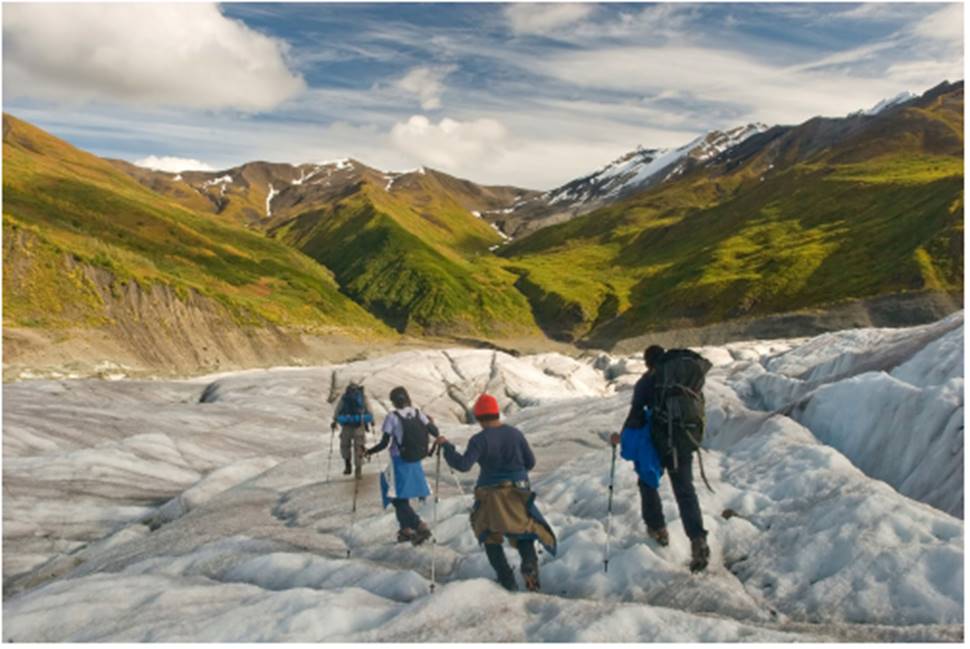Sentinels of Climate Change: The Rapid Melting of Glaciers and Its Global Impact
Glaciers emerge when fallen snow is compacted over the years. The mass of ice flows much like a river, creating glaciers that can range from the size of a football field to several hundreds of miles. Due to their origin in compacted snow, glaciers are most abundant in high latitudes or high altitudes. It is estimated that glaciers cover as much as 10 percent of the land area. Global climate change will greatly reduce this number, and the reduction of glaciers serves as one of the major indicators of the human- centered influences on the climate. Glaciers only form on land and thus distinguish themselves from the sea ice forming on top of the oceans. Although glaciers are largely terrestrial features, their predicted melting will greatly influence sea water levels in the near future.
As the twenty-first century dawned, ice was melting around the world. The Intergovernmental Panel on Climate Change’s models project that between one-third and one-half of the existing mountain glacial mass could disappear over the next 100 years. Sometime during the present century, the last glacier may melt in Glacier National Park.
Human-induced climate change may be ending the cycle of glaciation that has been the norm on Earth for millions of years. Viewed on a timescale of the last 540 million years, however, glacial cycles have been relatively rare events. For three-quarters of the last 540 million years, the Earth’s ice caps have been negligible or nonexistent.
“We know the ice can change fast,” said Eric Rignot, a professor of earth sciences at the University of California, Irvine. “We've never seen it. No human has ever seen it” (Gertner 2015). Rignot is fairly confident, however, that we are seeing it now—a conclusion borne out by the ice sheet data he scrutinizes every week. A few decades from now, he said, we may look back with regret, wondering why more of us didn't acknowledge the signs all around us, why we didn't see “that the collapse had already started.” Greenland, home to many glaciers, was by 2015 losing about 303 billion tons of ice a year.

Hikers traverse a glacier in Alaska’s Wrangell-St. Elias National Park, the largest national park in the United States (Dreamstime.com)
The melting of glaciers, which has been most prominent in the polar regions, has a number of wide-ranging effects. It will lead to a rise of the sea levels, which in turn threatens low-lying islands and continental shorelines. Shrinking glaciers also reduce the reflection of sun rays off the ice, the albedo effect, which will increase the temperature around the Earth.
The effects of melting ice are not restricted to polar regions. A slice of mountain glaciers’ rapid erosion in temperate regions worldwide has been provided by researchers from Turkey’s Ege University and NASA’s Goddard Space Flight Center, who analyzed forty- one years of Landsat data to document a decline of fourteen glaciers in that country from 25 km2 (10 m2) to 11 km2, or 4.19 m2. Five of the glaciers have melted completely. They attributed glacier recession to higher summer minimum temperatures, with no changes in precipitation or cloud cover over this time period. By 2015, only two substantial glaciers remained in Turkey. One of them, on Mount Suphan, a dormant volcano, has lost 75 percent of its ice. Most of its ice is now covered by debris. And so it is around the world, as ice melts at the poles and mountains, usually quietly, out of human sight.
Glaciers have been aptly called the “Sentinels of Climate Change.” Their rapid melting negates centuries of ice build-up. These frozen rivers cover about 10 percent of the land surface—well over half located in Alaska, Arctic Canada, and Greenland—but hold an estimated 70 percent of the earth’s freshwater supply. Compared to sea ice, glaciers’ contribution to sea-level rises and albedo effects—estimated at 20 percent—seems lower than expected. However, their role as indicators for dramatic changes to come, mainly when observed from space, and their decreasing capacity to retain a great volume of the planet’s drinking water make their impact so much more pronounced. Bruce E. Johansen
FURTHER READING:Gertner, Jon. 2015. “The Secrets in Greenland’s Ice Sheet.” New York Times Sunday Magazine. http://www.nytimes.com/2015/11/15/magazine/the-secrets-in-greenlands-ice-sheets.html. Accessed November 12, 2016.
Hambrey, Michael and Alean Jurg. 2004. Glaciers, second edn. Cambridge: Cambridge University Press.
Huber, Brian T., Kenneth G. MacLeod, and Scott L. Wing. 2000. Warm Climates in Earth History. Cambridge: Cambridge University Press.
Loya, Wendy M. and Paul Grogan. 2004. “Carbon Conundrum on the Tundra.” Nature 431 (September 23): 406-7.
McGrath, Susan. 2011. “On Thin Ice.” National Geographic (July): 64-75.
NASA Earth Observatory. 2015. “Turkish Glaciers Shrink By Half.” http://earthobservatory.nasa .gov/IOTD/view.php?id = 86140&src=eoa-iotd. Accessed November 12, 2016.
Yavasli, D. D., C. J. Tucker, and K. A. Melocik. 2015. “Change in the Glacier Extent in Turkey during the Landsat Era.” Remote Sensing of Environment 163: 32-41. http://www.sciencedirect .com/science/article/pii/S003442571500098X. Accessed November 12, 2016.
Date added: 2025-10-14; views: 125;
